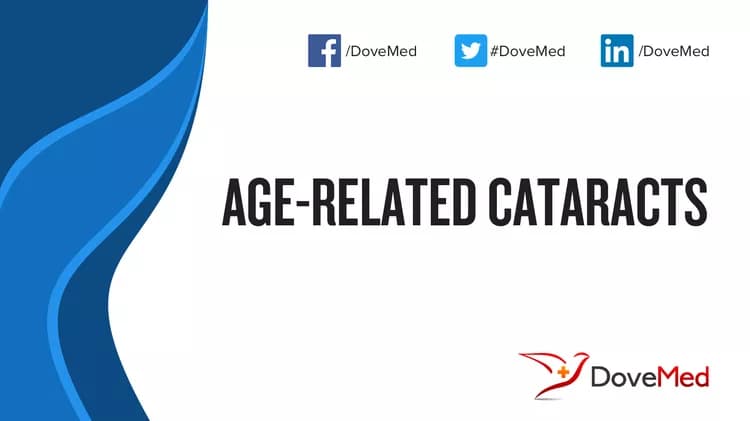What are the other Names for this Condition? (Also known as/Synonyms)
- Geriatric Cataract
- Senile Cataract
What are Age-Related Cataracts? (Definition/Background Information)
- Age-Related Cataracts refer to the gradual clouding of the eye's natural lens that occurs as a result of aging. This eye condition can gradually lead to blurred vision and visual impairment. It is generally seen in adults over 60 years of age and is the most common form of cataract
- The signs and symptoms of Age-Related Cataracts also include cloudy vision, increased sensitivity to glare, difficulty seeing in low-light conditions, and a need for brighter light when reading or performing close-up tasks. Colors may also appear faded or yellowed
- An eye specialist, such as an ophthalmologist or optometrist, can diagnose Age-Related Cataracts through a comprehensive eye examination. This typically involves visual acuity tests, pupil dilation, and a thorough evaluation of the lens's clarity
- In the early stages, vision changes caused by cataracts can often be managed with changes in eyeglass prescriptions and improved lighting. However, as Age-Related Cataracts progress and significantly affect vision and quality of life, surgery to remove the cloudy lens and replace it with an artificial intraocular lens (IOL) becomes the primary treatment
- Cataract surgery is considered one of the most common and successful surgical procedures. It usually leads to a significant improvement in vision and quality of life for individuals with age-related cataracts. The prognosis of Age-Related Cataracts is generally excellent, with most patients experiencing improved visual clarity and the ability to resume daily activities with minimal restrictions after surgery.
Who gets Age-Related Cataracts? (Age and Sex Distribution)
- Age-Related Cataracts primarily affect individuals as they advance in age, typically over the age of 60
- Both men and women are susceptible to developing cataracts
- The condition is observed across all racial and ethnic groups worldwide
What are the Risk Factors for Age-Related Cataracts? (Predisposing Factors)
The risk factors for Age-Related Cataracts may include:
- Increasing age
- Family history of cataracts
- Exposure to sunlight and ultraviolet (UV) radiation
- Diabetes
- Smoking
- Certain medications, for e.g., corticosteroids
- Previous eye injuries or inflammation
It is important to note that having a risk factor does not mean that one will get the condition. A risk factor increases one’s chances of getting a condition compared to an individual without the risk factors. Some risk factors are more important than others.
Also, not having a risk factor does not mean that an individual will not get the condition. It is always important to discuss the effect of risk factors with your healthcare provider.
What are the Causes of Age-Related Cataracts? (Etiology)
The primary cause of Age-Related Cataracts is the gradual breakdown of proteins within the lens of the eye. This process leads to the accumulation of protein clumps, causing the lens to become cloudy and affecting vision.
What are the Signs and Symptoms of Age-Related Cataracts?
The signs and symptoms of Age-Related Cataracts may include:
- Blurred, hazy, or cloudy vision
- Increased sensitivity to glare, particularly from headlights and sunlight
- Difficulty seeing at night
- Fading or dulling of colors
- Frequent changes in eyeglass or contact lens prescriptions
How are Age-Related Cataracts Diagnosed?
The diagnosis of Age-Related Cataracts may involve the following tests and exams:
- Physical examination and medical history evaluation
- Eye examination by an ophthalmologist is necessary for diagnosing Age-Related Cataracts
- Other tests performed by the healthcare provider may include:
- Slit-lamp biomicroscopy
- Dilated eye exam (dilated fundus examination)
- Visual acuity test
- Tonometry, to measure eye pressure
Many clinical conditions may have similar signs and symptoms. Your healthcare provider may perform additional tests to rule out other clinical conditions to arrive at a definitive diagnosis.
What are the possible Complications of Age-Related Cataracts?
The complications of Age-Related Cataracts may include:
- Vision impairment or blindness if left untreated
- Difficulty performing daily activities
- Increased risk of falls and accidents due to poor vision
How are Age-Related Cataracts Treated?
Surgery is the most common treatment for Age-Related Cataracts. During cataract surgery, the cloudy lens is removed and replaced with an artificial lens called an intraocular lens (IOL). This procedure is highly effective in restoring clear vision.
How can Age-Related Cataracts be Prevented?
While cataracts cannot be completely prevented, certain measures may be taken to reduce the risk of developing Age-Related Cataracts, including:
- Wear sunglasses that block UV radiation
- Manage health conditions like diabetes
- Quit smoking
- Maintain a healthy diet rich in antioxidants
- Get regular eye exams
What is the Prognosis of Age-Related Cataracts? (Outcomes/Resolutions)
- Cataract surgery is highly successful in restoring clear vision for most individuals with Age-Related Cataracts, and it has a low risk of complications
- The prognosis is generally positive, with improved visual acuity and quality of life after surgery
Additional and Relevant Useful Information for Age-Related Cataracts:
- A cataract is defined as opacification (to become opaque) or clouding of the natural clear lens that results in visual problems, including blindness
The following resource link may help in better understanding cataracts:
Related Articles
Test Your Knowledge
Asked by users
Related Centers
Related Specialties
Related Physicians
Related Procedures
Related Resources
Join DoveHubs
and connect with fellow professionals


0 Comments
Please log in to post a comment.